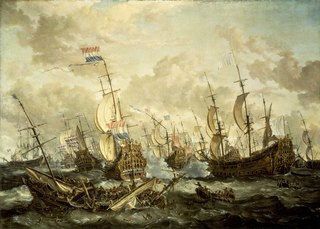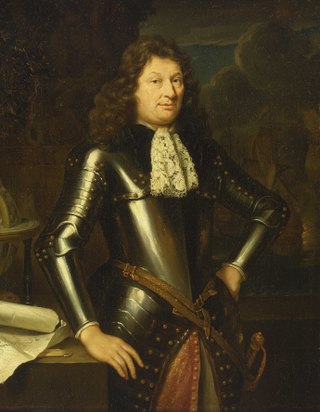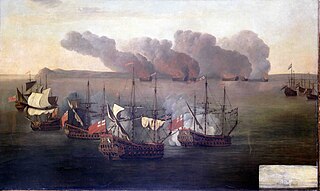
The Four Days' Battle was a naval engagement fought from 11 to 14 June 1666 during the Second Anglo-Dutch War. It began off the Flemish coast and ended near the English coast, and remains one of the longest naval battles in history.

The Battle of Lowestoft took place on 13 June [O.S. 3 June] 1665 during the Second Anglo-Dutch War. A fleet of more than a hundred ships of the United Provinces commanded by Lieutenant-Admiral Jacob van Wassenaer, Lord Obdam, attacked a British fleet of equal size commanded by James, Duke of York, forty miles east of the port of Lowestoft in Suffolk.

Philips van Almonde was a Dutch States Navy officer who served in his nation's maritime conflicts of the 17th and early 18th centuries.

Abraham van der Hulst was a Dutch admiral in the 17th century.
HMS Ruby was a 40-gun frigate of the Commonwealth of England, built by Peter Pett at Deptford. She took part in actions during all three of the Anglo-Dutch Wars of 1652–1654, 1665–1667 and 1672–1674. She later served in the West Indies, and in 1683 was sent to the Leeward Islands to protect British settlements against Caribbean pirate raids. In 1687, the English pirate Joseph Bannister was captured by the crew of Ruby and brought to Port Royal for trial. She was rebuilt in 1687. She was captured by the French in October 1707.

HMS Adventure was a 34-gun fourth-rate of the English Navy, built by Peter Pett II at Woolwich Dockyard and launched in 1646. With the outbreak of the English Civil War she served on the Parliamentary side until 1649. She was incorporated into the Commonwealth Navy in 1650. She partook in the Battle off Dover in 1652, the Battle of Portland and the Battle of Gabbard in 1653. Adventure was employed on Bulstrode Whitelocke's embassy to Sweden, 1653–1654. After the Restoration she was incorporated into the Royal Navy. She was present at the Battle of Lowestoft (1665) and the Battle of Solebay (1672). She also participated in the Golden Horse and Two Lions actions in 1681. She was in the Battle of Barfleur in 1692. She captured several ships in the later part of her career, before being captured by the French in 1709.
Sapphire was a 38-gun fourth-rate of the Commonwealth of England. After commissioning she was actively involved in the First Anglo-Dutch War participating in most major fleet actions. During the Second Anglo-Dutch War she was only in the first two engagements then spent her time in Irish Waters and the Mediterranean. She was run ashore due to a pending attack by suspected Algerian pirates on Sicily in March 1670.
HMS Reserve was one of six 40-gun fourth-rate frigates, built for the Commonwealth of England under the 1650 Programme, after the Restoration of the monarchy in 1660 she was incorporated into the navy of the Kingdom of England. She partook in no major Fleet actions during the First Anglo-Dutch War. After the Restoration during the Second Anglo-Dutch War she partook in the Battle of Lowestoft, the Four Days' Battle and the St James Day Battle. She spent the bulk of her service either in the Mediterranean or at Newfoundland. She foundered off Yarmouth in November 1703.

HMS Centurion was one of six 40-gun fourth-rate frigates, built for the Commonwealth of England under the 1650 Programme, she would be transferred to the navy of the Kingdom of England upon the Restoration of the monarchy in May 1660. When commissioned she partook in the First Anglo-Dutch War. After the first war ended she was in the Mediterranean fighting the Algerines at the Battle of Santa Cruz. She fought the battles of Dover, Portland, the Gabbard, and Scheveningen. During the Second Anglo-Dutch War she partook in the battles of Lowestoft and Orfordness. Following the second war she spent her time either in North America or the Mediterranean. She was wrecked in a storm in December 1689.
HMS Assistance was one of six 40-gun fourth-rate frigates, built for the Commonwealth of England under the 1650 Programme, after the Restoration of the monarchy in 1660 she was incorporated into the navy of the Kingdom of England. During her time in the Commonwealth Navy she partook in the First Anglo-Dutch war being present in the battles of Kentish Knock, Portland and The Gabbard. In the Mediterranean she was present at the Battle of Santa Cruz and the bombardment of Porto Farina, In the Second Anglo-Dutch War she was involved in the Battle of Lowestoft, Battle of Vagen and the St James Day Fight. She did not participate in fleet actions after this. She spent the rest of her service life undergoing several rebuilds and plying the waters as a cruiser protecting British trade and projecting British sovereignty. After nearly 95 years of Service she was sunk as a break water at Sheerness at the end of 1745.

Johan Evertsen de Liefde was a Dutch naval commander who served as vice admiral of Holland and West Frisia within the Admiralty of Rotterdam. His elder brother, Cornelis de Liefde, was also a naval commander. Johan was killed in the battle of Texel.

Admiral Sir John Harman was an English officer of the Royal Navy, who served first under the Commonwealth, then Charles II following the 1660 Stuart Restoration.
HMS Portsmouth was a 34-gun fourth-rate of the English Navy, built by Thomas Eastwood at Portsmouth Dockyard and launched in 1649. She was incorporated into the Commonwealth Navy in 1650. She partook in the Battle off Dover and Kentish Knock in 1652, the Gabbard and Scheveningen in 1653. After the Restoration she was incorporated into the Royal Navy. She was present at the Battle of Lowestoft (1665) and the Four Days Battle. She was present at the Texel in 1673, the Battle of Bantry Bay in 1689. She was captured by the French in August 1689 and blown up.
Guinea was a 38-gun fourth rate vessel of the Kingdom of England, Her initial commission was as a Royalist vessel during the English Civil War named Charles. She was captured then commissioned into the Parliamentary Naval Force as Guinea. During the First Anglo-Dutch War she partook in the Battle of Kentish Knock, the Battle of Portland and the Battle of The Gabbard. During the Second Anglo-Dutch War she participated in the Battle of Lowestoft, the Battle of Vagen and the St James Day Fight. She was sold on 27 November 1667.
Marmaduke was a 40-gun fourth rate vessel of the Kingdom of England, Her initial commission was as a Royalist vessel during the English Civil War named Revenge. She defected to the Parliamentarians then commissioned as Marmaduke. During the First Anglo-Dutch War she partook in the Battle of The Gabbard. During the Second Anglo-Dutch War she participated in the Four Days' Fight. She was scuttled during the Dutch raid on the Medway and sold in 1669.
Amity was a 36-gun fourth rate vessel, formerly belonging to the Commonwealth of England. She was hired by Parliament in November 1649, and later purchased on 18 January 1650, thus renamed. She was commissioned into the Parliamentary Naval Force as Amity. During the First Anglo-Dutch War she partook in the Battle of Portland and the Battle of The Gabbard. Later, after the Restoration in May 1660, she was incorporated into the English Navy. During the Second Anglo-Dutch War she participated in the Battle of Lowestoft, the Four Days' Battle and the St James Day Fight. She was sold on 27 November 1667.
Convertine was a 36-gun fourth rate vessel captured from the Portuguese by the Commonwealth of England. She was commissioned into the Parliamentary Naval Force as Convertine. During the First Anglo-Dutch War she partook in the Battle of Dungeness, Battle of Portland and the Battle of the Gabbard. During the Second Anglo-Dutch War she participated in the Battle of Lowestoft and the Four Days' Battle. She was captured during the Four Days' Battle.
The English ship Drake was a 14-gun sixth rate vessel built under the 1651 Programme at Deptford Dockyard for the Commonwealth of England in 1651/52. During her time in the Commonwealth Navy she spent her time patrolling Home Waters and did not participate actively in the First Anglo-Dutch War. On the restoration she was incorporated into the Royal Navy as HMS Drake. During the Second Anglo-Dutch War she fought in the Battle of Lowestoft. She spent the rest of her career patrolling Home Waters before going to Jamaica. She was sold in Jamaica in 1691.
The English ship Martin was a 14-gun sixth rate vessel built under the 1651 Programme at Portsmouth Dockyard for the Commonwealth of England in 1651/52. Her service in the Commonwealth Navy was very active. She participated in the Battles of Dover, Portland and the Gabbard. She was with Robert Blake at Porto Farina. She was the main vessel at the Capture of Jamaica in 1655. With the Restoration she became HMS Martin. During the Second Anglo-Dutch War she was in the initial battle of Lowestoft then the Battle of Vagen. She was sold in February 1667.








